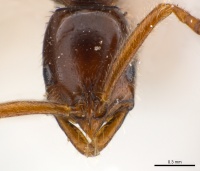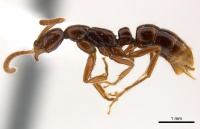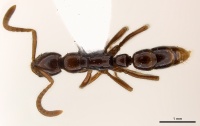Leptogenys amu
| Leptogenys amu | |
|---|---|

| |
| Scientific classification | |
| Kingdom: | Animalia |
| Phylum: | Arthropoda |
| Class: | Insecta |
| Order: | Hymenoptera |
| Family: | Formicidae |
| Subfamily: | Ponerinae |
| Tribe: | Ponerini |
| Genus: | Leptogenys |
| Species group: | quiriguana |
| Species: | L. amu |
| Binomial name | |
| Leptogenys amu Lattke, 2011 | |
Nothing is known about the biology of Leptogenys amu.
Identification
Lattke (2011) - Head longer than wide in full-face view; widest at mid-length; scape surpasses posterior cephalic border by less than two apical widths; mesosomal dorsal margin forms continuous line in lateral view; petiole subrectangular in lateral view, higher than long; node subquadrate in dorsal view; wider posterad than anterad.
This species, along with Leptogenys quiriguana are the smallest of the quiriguana species group. L. amu is easily separated from the other species by lacking a distinctly transverse mesonotum and has the southernmost distribution, the other species being found from Central America to the Coastal Cordillera of northern South America.
Keys including this Species
Distribution
Latitudinal Distribution Pattern
Latitudinal Range: 0.213333333° to 0.213333333°.
| North Temperate |
North Subtropical |
Tropical | South Subtropical |
South Temperate |
- Source: AntMaps
Distribution based on Regional Taxon Lists
Neotropical Region: Colombia (type locality), French Guiana.
Distribution based on AntMaps
Distribution based on AntWeb specimens
Check data from AntWeb
Countries Occupied
| Number of countries occupied by this species based on AntWiki Regional Taxon Lists. In general, fewer countries occupied indicates a narrower range, while more countries indicates a more widespread species. |

|
Estimated Abundance
| Relative abundance based on number of AntMaps records per species (this species within the purple bar). Fewer records (to the left) indicates a less abundant/encountered species while more records (to the right) indicates more abundant/encountered species. |

|
Biology
|
Castes
The queen and male are unknown.
Nomenclature
The following information is derived from Barry Bolton's Online Catalogue of the Ants of the World.
- amu. Leptogenys amu Lattke, 2011: 200, fig. 55 (w.) COLOMBIA.
Unless otherwise noted the text for the remainder of this section is reported from the publication that includes the original description.
Description
Worker
Metrics, holotype (paratype): HL 0.95 (0.94); HW 0.63 (0.62); ML 0.43 (0.45); EL 0.15 (0.13); SL 0.82 (0.82); PW 0.58 (0.57); WL 1.49 (1.50); PH 0.57 (0.57); PL 0.45 (0.45); DPW 0.38 (0.40) mm. CI 0.67 (0.66); MI 0.68 (0.73); OI 0.24 (0.22); SI 1.29 (1.32); LPI 1.26 (1.26); DPI 0.85 (0.89).
Head longer than wide in full-face view; widest at mid-length; lateral margin broadly convex, posterior margin weakly concave to straight; vertexal carinae narrow, visible throughout most of posterior cephalic margin; eye mostly laterally placed with slightly dorsal extension, relatively flattened, separated from mandibular insertion by more than one diameter; median clypeal process triangular with pointed apex; lateral clypeal lobe narrow; clypeus with longitudinal strigae. Head mostly smooth and shining, with scattered piligerous punctulae. Scape smooth with sparse piligerous punctulae, decumbent pilosity and scattered subdecumbent to suberect hairs, scape surpasses posterior cephalic border by less than two apical widths; second and third antennal segments approximately same length; fourth antennal segment shorter than second and third antennal segments. Mandible shuts tight against clypeus, elongate, mostly parallel-sided, weakly widening apicad, basal margin mostly convex, with 3 – 4 hairs; mandibular dorsum smooth and shining, sparsely punctate; cephalic ventral face shining with weak longitudinal striae and sparse piligerous punctulae.
Mesosomal dorsal margin forms continuous line in lateral view; promesonotal margin broadly convex; dorsal propodeal margin mostly straight; dorsal propodeal margin almost 2 × length of declivitous margin. Mesosoma mostly smooth and shining; mesonotum wider than long, anterior margin convex, posterior margin broadly convex, metanotal groove distinctly impressed. Mesometapleural suture well impressed, scrobiculate; propodeal spiracle small, rounded to oval, laterally to posterolaterally facing; mesopleuron with triangular anterior lobe, anteroventral carinae distinct; propodeum with low, blunt tooth at spiracular height; declivity transversely striate. Cervix with transverse striae; prosternal process with posterior minute denticle in lateral view.
Petiole subrectangular in lateral view, higher than long; dorsal margin broadly convex, highest posterad; posterior margin straight to very broadly convex; triangular ventral tooth present; node subquadrate in dorsal view; wider posterad than anterad, anterior margin convex, more than half as wide as posterior margin, posterior margin mostly straight, lateral margin straight to weakly convex; postpetiolar anterior margin vertical in lateral view, with distinct blunt angle separating broadly convex dorsal margin. Node and gaster smooth and shining; procoxa smooth and shining in lateral view; head, thorax, and most of abdomen brown; antenna, clypeus, mandibles, legs and apical gastral segments ferruginous. Body with sparse short standing hairs, no appressed pilosity; apex of pro- and metatibiae lacking setae, mesotibial apex with single seta.
Type Material
Holotype worker. Colombia, Caqueta´, Puerto Solano, P.N.N. La Serrani´a de Chiribiquete, Ri´o Cun~are´ – [Ri´o] Amu, 0°12'48N 72°25'3.2W, 250 m, 19.–22.ii.2001, M. Ospina, E. Gonza´lez, deposited in IAvH (No. 35074). – Paratype. One worker with same locality data as holotype, deposited in IAvH (No. 35081). The paratype specimen lacks its gaster.
Etymology
The species name is derived from the name of the locality where the specimens were collected.
References
- Franco, W., Ladino, N., Delabie, J.H.C., Dejean, A., Orivel, J., Fichaux, M., Groc, S., Leponce, M., Feitosa, R.M. 2019. First checklist of the ants (Hymenoptera: Formicidae) of French Guiana. Zootaxa 4674, 509–543 (doi:10.11646/zootaxa.4674.5.2).
- Lattke, J.E. 2011. Revision of the New World species of the genus Leptogenys Roger (Insecta: Hymenoptera: Formicidae: Ponerinae). Arthropod Systematics & Phylogeny, 69, 127-264.
References based on Global Ant Biodiversity Informatics
- Franco W., N. Ladino, J. H. C. Delabie, A. Dejean, J. Orivel, M. Fichaux, S. Groc, M. Leponce, and R. M. Feitosa. 2019. First checklist of the ants (Hymenoptera: Formicidae) of French Guiana. Zootaxa 4674(5): 509-543.

